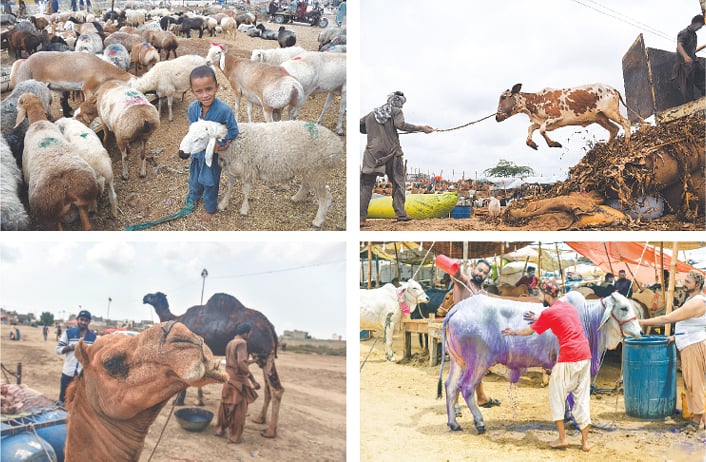KARACHI: After another late night of razzle-dazzle it is yet another morning at the city’s biggest livestock market at Sohrab Goth. The animals were resting, some were munching and chewing on feed while others were freshening up.
Mind you, it was no ordinary freshening up. The keepers and caretakers of the animals lathered them up using body wash and shampoo to keep their coats soft to the touch for interested buyers. The ones with white coats were then drenched in blue ‘neel’, which was also washed off. The ‘neel’, one was informed, worked just like it works on laundry. It would turn their white coat brilliant white, especially under the bright lights they turned on in the evenings.
The livestock market management gives 16 litres of water for each animal’s drinking needs. But for washing them their owners need to buy extra water. A big blue water can costs them Rs500 each but they are fine with that as long as they were able to keep their animals clean so they fetch a good price.
It is still 10 days before Eidul Azha. The sellers were expecting the sales to really pick up close to Eid.
The buyers start arriving after 6pm when the sun is setting and the weather has cooled down. That’s when the lights are turned on and the animals are all made to remain standing for showtime.
As Eidul Azha draws near, city’s biggest livestock market shines at night under strict monitoring of sick animals
The bigger stalls owned by various cattle farms have all been nicely decorated. They are all very well lit with chandeliers included among their lights. The chandeliers sway in the evening breeze and double as wind chimes.
The livestock market has it all — cattle, goats, sheep and camels. It has specific areas for all the different species that are been broken down even further. For example, the cattle market is divided by areas of the animals’ origins. There is an area reserved for cattle from Sindh, another for cattle from Balochistan and yet another for the Punjab variety.
The cattle prices range from Rs90,000 to millions. The most expensive animal there is not even for sacrifice and it recently received an offer of Rs30 million. It is called ‘Rani’. Rani is a very small variety of a cow. It is the size of a dog. The person who offered to buy Rani said he would be keeping it at home as a pet.
The age of the animals is determined by his or her front teeth. In cattle and big animals two teeth mean approximately two or two-and-a-half years of age.
However, in goat and sheep two teeth mean over one year of age, which happens to be the most sought after age for a sacrificial animal.
It means that they are neither too young nor too old. They are just the right age, when they are young and healthy.
The health of the animals is being carefully monitored at the livestock market.
A truck full of cattle with even one sick animal is returned along with all of its animals. That way several hundred thousand animals have been returned to their farms so far.
Goat market
The goat and sheep market adjoins the cattle market. Here you get to see all kinds of goats. There is the expensive ‘Kaamori’ goat from Tando Adam, which is fair-coloured mostly and long-legged.
There is the Sindhi ‘Odho’ variety, which is not too tall but healthy. There is also the petite Indonesian goat. Another with a dark coat and stout legs is said to hail from Sudan. It’s seller was asking Rs250,000 for it and he was willing to even throw in it’s kid for free in the deal.
The cheapest goat in the market was said to cost around Rs50,000. However, a good deal can always be made through bargain. Seeing a really small one behind a stall of decorative items for livestock, I asked if it was worth that much only to be informed that it was around Rs70,000. That was when I wondered how miniscule a Rs50,000 goat could be? But it was not in our stars to meet.
Camel market
The camel market was at a little distance from the cattle and goat markets. Here you found no tents or shades over the camels as camels known to be desert animals.
Most of the camels at this market hailed from Tharparkar. Some were 10 years old, some seven or eight years old. And all looked quite chill sitting and munching away on their feed as they rested on the mud with their owners keeping an eye on them.
Some owners were applying henna over their camels’ entire bodies to make their coats black or orange in colour. Some were making pretty patterns with the henna or their necks or backs.
The camel prices could be compared to the cattle prices. The cheapest camel here cost Rs300,000 and the most expensive one cost Rs3m.
But these prices were for the local varieties only. There was also a man there selling camels that he had brought from Tajikistan.
They were no ordinary camels, too. They had two humps. Asked if he was going to breed these camels here in Pakistan, the man quickly shook his head to inform that he only had male camels that he wanted to sell off as sacrificial animals. He was asking Rs4.5m for his most expensive camel and Rs1.5m for his least costly camel.
Published in Dawn, July 1st, 2022
















































Dear visitor, the comments section is undergoing an overhaul and will return soon.